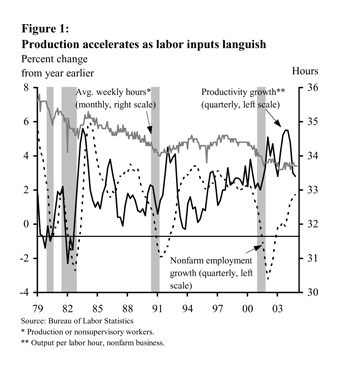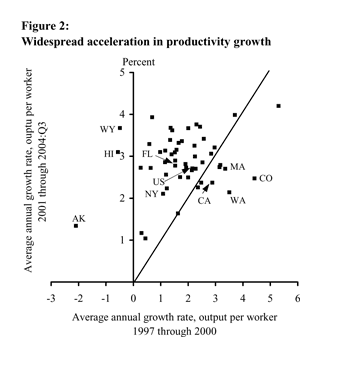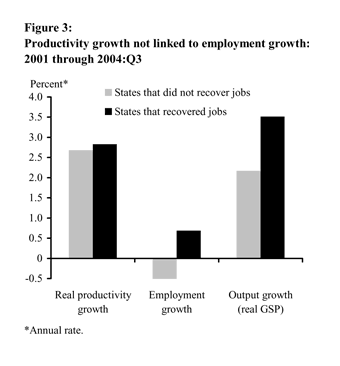The performance of productivity in the U.S. economy has delivered some big surprises over the last several years. One surprise was in the latter half of the 1990s, when productivity growth surged to average an annual rate of over 3%, more than twice as fast as the rate in the previous two decades.
|
The performance of productivity in the U.S. economy has delivered some big surprises over the last several years. One surprise was in the latter half of the 1990s, when productivity growth surged to average an annual rate of over 3%, more than twice as fast as the rate in the previous two decades. A bigger surprise has been the further ratcheting up of productivity growth since the most recent recession. Even with a slowing to below a 1-3/4% annual pace in the second half of last year, productivity growth averaged around 3.8% for the 2001 through 2004 period. That is an extraordinarily high number by historical standards. It also is well above the consensus view among economists, which is that trend growth of productivity is on the order of 2-1/2% (see Yellen 2005).
Although considerable research has uncovered the primary drivers of the late 1990s surge in productivity growth, the factors pushing productivity growth above its presumed trend in more recent years are less well understood. One possibility is that the very rapid pace of productivity growth since the recent recession reflected the lagged effects of past capital investment and increased efficiency in workplace organization. In that case, gains in the level of productivity should stick, as its growth proceeds closer to trend. Another possibility, however, is that a significant portion of the extraordinary gains reflected stopgap measures that gave only a temporary boost to productivity. For example, since the recession, it has been common to hear stories about “business caution” brought on by an environment still jolted by the effects of September 11, 2001, the wars in Afghanistan and Iraq, the IT bust, and corporate governance scandals. This caution may have led businesses to meet increases in demand by pushing their existing workers harder, perhaps to unsustainable levels, rather than by hiring more workers. Therefore, as businesses become more confident and expand hiring, the unwinding of the earlier, temporary gains in productivity would push productivity growth below its underlying trend.
This Economic Letter uses state-level data to contribute to the analyses of the drivers of gains in U.S. labor productivity since 2000—stopgap measures among cautious employers or more lasting changes. While the nation has had a so-called jobless recovery, many states posted net job gains early in the recovery and regained previous peaks in employment levels well ahead of the nation. Comparing states with and without job recoveries, we find no significant difference in productivity growth. The results indicate that differences in demand (output) rather than differences in productivity growth have been the primary drivers of job growth across states. Moreover, the breadth of the gains in the level of productivity suggests that they will be long-lasting.
Growth in U.S. productivity and labor inputs
 Figure 1 plots U.S. labor productivity growth, growth in nonfarm payroll employment, and average weekly hours worked. As the figure illustrates, during the latter half of the 1990s, jobs and productivity grew rapidly as the nation’s growth frenzy made workers hard to find and led firms to add capital equipment quickly to meet surging demand. After 2001, in contrast, the further accelerations in productivity growth were accompanied by languishing national employment until late in 2003. Moreover, unlike the jobless recovery of the early 1990s, this cycle saw average weekly hours for production and nonsupervisory workers edge down, not up. This combination of enduring rapid productivity growth and the edging down of average weekly hours seems to support the view that gains in the level of productivity were probably not largely the result of temporary, stopgap measures.
Figure 1 plots U.S. labor productivity growth, growth in nonfarm payroll employment, and average weekly hours worked. As the figure illustrates, during the latter half of the 1990s, jobs and productivity grew rapidly as the nation’s growth frenzy made workers hard to find and led firms to add capital equipment quickly to meet surging demand. After 2001, in contrast, the further accelerations in productivity growth were accompanied by languishing national employment until late in 2003. Moreover, unlike the jobless recovery of the early 1990s, this cycle saw average weekly hours for production and nonsupervisory workers edge down, not up. This combination of enduring rapid productivity growth and the edging down of average weekly hours seems to support the view that gains in the level of productivity were probably not largely the result of temporary, stopgap measures.
Digging beneath the aggregate U.S. data, a number of studies have examined the rise in the growth of labor productivity in the latter part of the 1990s using industry-level data. These studies find that the acceleration was broad-based, with most major industry groups participating. In addition, the industry-level studies also have helped sort out the causes of the acceleration, finding that investment in information technology (IT) played an important role in most industries (Stiroh 2002, Fernald and Ramnath 2003). The breadth of the productivity growth acceleration convinced many that the gains were more permanent.
Evidence from state-level data
Like industry-level data, state-level data give us multiple observations of the relationships among output, productivity, and employment growth for a given time period. Since state economies are not perfectly synchronized with the national business cycle, state patterns give us some further insight into the future paths of productivity growth.
In using state data, we define labor productivity as the real value of output per worker. Specifically, we define productivity as the value of real output (value-added output) produced by nonfarm industries in each state, divided by the number of workers employed by the respective industries in each state. The data on job counts are from the nonfarm payroll employment series released by the Bureau of Labor Statistics (BLS). The data for real output by state through 2002 are from the Bureau of Economic Analysis (BEA). The data for real output by state for 2003 and 2004 are estimated by the Federal Reserve Bank of San Francisco; estimated growth rates are available on the Quick Stats page of the website for the Center for the Study of Innovation and Productivity. Although the BEA and FRBSF data are computed differently from the BLS productivity data, when aggregated, these measures of output per worker closely track the pattern for the nation’s productivity growth shown in Figure 1.
 The first question we ask is: was the pickup in U.S. average productivity growth after 2000 geographically widespread or concentrated in relatively few states? Figure 2 provides an answer by plotting average annual productivity growth over the period 1997 through 2000 compared with the period 2001 through 2004:Q3. (For the nation, estimates suggest that an acceleration in productivity growth began in 1997; see Edge, Laubach, and Williams 2004 for a detailed description of this trend break.) Points above the 45-degree line represent states (including the District of Columbia) that experienced acceleration in productivity growth in the latter period.
The first question we ask is: was the pickup in U.S. average productivity growth after 2000 geographically widespread or concentrated in relatively few states? Figure 2 provides an answer by plotting average annual productivity growth over the period 1997 through 2000 compared with the period 2001 through 2004:Q3. (For the nation, estimates suggest that an acceleration in productivity growth began in 1997; see Edge, Laubach, and Williams 2004 for a detailed description of this trend break.) Points above the 45-degree line represent states (including the District of Columbia) that experienced acceleration in productivity growth in the latter period.
Clearly, the majority of states did experience an acceleration in productivity growth in the 2001 through 2004:Q3 period, including those with very different economic makeups, such as Florida, Hawaii, New York, Tennessee and Wyoming. Among the states that did not realize an acceleration in productivity growth, most posted relatively strong gains in the 1997-2000 period. It is worth noting that some of the latter states are significant IT centers, such as California, Colorado, Massachusetts, and Washington, and their relatively strong productivity gains in the earlier period coincided with the IT boom; this productivity growth advantage unwound to an extent in recent years as the IT sector turned down.
The next question is: does the pickup in productivity growth among so many states with diverse economic makeups suggest fundamental, long-lasting improvements in the level of productivity or the temporary, albeit broad-based, effects of business caution? We address this question by examining the relation between productivity and job growth across U.S. states during the 2001 through 2004 period. As of September 2004, nonfarm payroll jobs were at or above the pre-U.S. recession levels for 21 states, which account for a little over one-fourth of total nonfarm payroll employment in the U.S. If the acceleration in productivity growth had been due largely to cautious employers pushing their existing workforces harder, we would expect to see some negative correlation between employment growth and productivity growth across states—in other words, either faster employment growth and slower productivity growth or vice versa. The idea is that, if a firm had confidence to expand employment, it would be less likely to engage in stopgap measures to raise productivity.
What do the data show? For the period 2001 through 2004, we find no statistically significant relationship between productivity growth and employment growth across the U.S. states. To account for possible differences in underlying productivity, employment, and output growth, we also examined the relationships in the changes in these growth rates in recent years compared to previous periods. That analysis indicates positive but generally not statistically significant correlations between changes in employment and productivity growth. The absence of a negative relationship between productivity growth and employment growth is consistent with a wide range of firms working to make long-lasting improvements in efficiency.
 Indeed, it appears that the states’ employment growth rates in recent years have been related to output growth, rather than to productivity growth. This can be seen in Figure 3, which shows average productivity, employment, and output growth (GSP, or gross state product) for states that had not recovered jobs lost during the recession and those with employment levels at or above pre-recession levels. Average productivity growth across these groups is virtually the same (not different statistically). Employment and output growth, on the other hand, diverge, with fast growing states posting solid job growth, while the other states on balance have had jobless recoveries. For many firms, the gains in productivity have been sufficiently large to meet demand for their products, while firms facing stronger demand have been willing to hire new workers to meet it.
Indeed, it appears that the states’ employment growth rates in recent years have been related to output growth, rather than to productivity growth. This can be seen in Figure 3, which shows average productivity, employment, and output growth (GSP, or gross state product) for states that had not recovered jobs lost during the recession and those with employment levels at or above pre-recession levels. Average productivity growth across these groups is virtually the same (not different statistically). Employment and output growth, on the other hand, diverge, with fast growing states posting solid job growth, while the other states on balance have had jobless recoveries. For many firms, the gains in productivity have been sufficiently large to meet demand for their products, while firms facing stronger demand have been willing to hire new workers to meet it.
What does this mean for the future?
The state-level data tell us that the U.S. productivity surge and coincident sluggish job growth in the recent recovery were not necessarily parts of the same phenomenon. The enormous gains in efficiency in the U.S. were pervasive among the states and not correlated with job growth. This is consistent with the view that the gains in the level of productivity we have observed are lasting and unlikely to be unwound substantially once employment growth picks up.
That does not mean that the growth rate of productivity will move back up to the elevated average pace seen in recent years. Even if the gains in the level of productivity realized over the past several years are retained, progress toward still higher levels of efficiency could come more slowly. Indeed, sustaining productivity growth at an average pace of close to 4% per year would be remarkable by historical standards. For example, if some of the very rapid pace of productivity growth during the recent recovery were the result of lagged effects from past investments in technology and changes in workplace practices, a diminution of those effects could mean slower productivity growth going forward. That said, evidence from the state data raises doubts that take-backs from earlier productivity gains will constitute a significant factor pushing productivity growth below its long-run trend.
Mary Daly
Vice President
Fred Furlong
Group Vice President
References
[URLs accessed March 2005.]
Edge, R., T. Laubach, and J.C. Williams. 2004. “Learning and Long-Run Shifts in Productivity.” FRBSF Working Paper 2004-04
Fernald, J. and S. Ramnath. 2003. “Information Technology and the U.S. Productivity Acceleration.” Chicago Fed Letter, Number 193.
http://www.chicagofed.org/publications/fedletter/2003/cflsept2003_193.pdf
Stiroh, K.J. 2002. “Information Technology and the U.S. Productivity Revival: What Do the Industry Data Say?” American Economic Review, Vol. 92, No. 5, pp. 1559-1576.
Yellen, J.L. 2005. “The U.S. Economic Outlook.” Presentation to the Stanford Institute for Economic Policy Research, February 11.
Opinions expressed in FRBSF Economic Letter do not necessarily reflect the views of the management of the Federal Reserve Bank of San Francisco or of the Board of Governors of the Federal Reserve System. This publication is edited by Anita Todd and Karen Barnes. Permission to reprint portions of articles or whole articles must be obtained in writing. Please send editorial comments and requests for reprint permission to research.library@sf.frb.org
